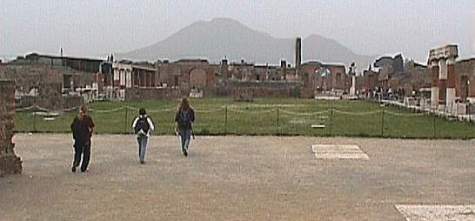|
|
|

|
|
|

Pompeii was a busy Roman town back just before the birth of Christ. Lots of people lived there, until one day, in 79AD, the mountain above the town exploded!
|
|
The mountain, Mt Vesuvius erupted with clouds of ash and smoke, and then lava poured down the mountainside. The people of Pompeii and Herculaneum rushed to the sea to escape, but not everyone got out in time. Some people and animals were overcome by the ash and fumes, and died in the streets and houses. Nothing was left of the town. |
|
Although this tragic event ended the lives of 20,000 Pompeian residents, the ash that buried the town served as a sort of mummification for the entire city. The eruption of 79 AD which buried the town in ash actually captured a moment in time. Under the ash everything stayed as it was at the time of the eruption. Artwork was preserved. Buildings were preserved. Several important clues were left behind. These clues give us a little glimpse into the past when you visit the ruins at Pompeii.
Here to the right you can see part of one of the mosaic floors built by the Romans. Each little square is a tiny piece of stone, and they are all cemented down to make a picture on the floor. |
|
|
|
The Romans also decorated their walls with paintings. They put plaster on the wall, and then painted this. These are called frescoes. You can see that the wall was painted a colour in the bottom half too. |
|
In this photo to the left you can see one of the roads through the town. Look carefully, and you will see the deep ruts in the stone made by the wheels of the carts and carriages. What do you think the high stones across the road were for? (Remember, these roads would be full of mud, and horse manure, and slops!) |
|